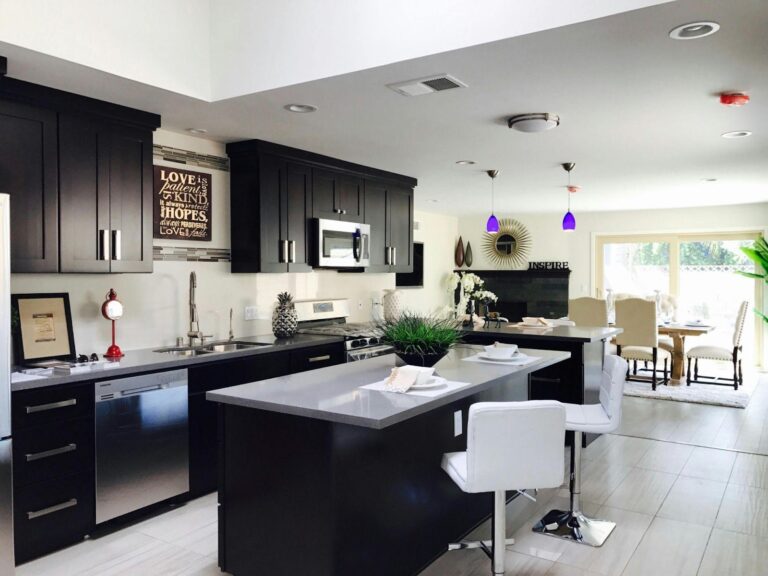
Image Source: FreeImages
Introduction to Chinese kitchens
As an avid traveler and lover of diverse cultures, I have always been fascinated by the unique culinary traditions and kitchen designs from around the world. One particular style that has captured my attention in recent years is the Chinese kitchen. With its rich history, intricate details, and functional elegance, Chinese kitchens have become a source of inspiration for modern home design, revolutionizing the way we perceive and utilize kitchen spaces.
In this article, I will delve into the captivating world of Chinese kitchens, exploring their traditional elements, their influence on contemporary design, and the innovative features that make them stand out. Whether you’re a homeowner seeking to incorporate Chinese elements into your kitchen or simply appreciate the beauty and functionality of this timeless style, this comprehensive guide will provide you with valuable insights and inspiration.
Traditional Chinese kitchen design elements
Chinese kitchen design is deeply rooted in the country’s rich cultural heritage and philosophical beliefs. One of the most prominent elements is the emphasis on harmony and balance, which is reflected in the layout and organization of the space. Traditional Chinese kitchens often incorporate the principles of feng shui, a ancient practice that aims to create a harmonious flow of energy within a space.
Some key traditional elements include:
- Wok Station: A dedicated area for the iconic wok, which is an essential cooking vessel in Chinese cuisine. This station is typically equipped with a powerful gas burner and ample counter space for preparation and cooking.
- Wooden Cabinetry: Intricately carved wooden cabinets and shelves are a hallmark of Chinese kitchen design. These not only add warmth and character but also serve as functional storage solutions.
- Tile Work: Intricate tile patterns and designs adorn the floors, walls, and countertops of traditional Chinese kitchens, adding a touch of elegance and cultural flair.
- Symbolic Decor: Chinese kitchens often incorporate symbolic elements, such as dragon motifs or calligraphy, which are believed to bring good fortune and prosperity.
The influence of Chinese kitchens on modern home design
In recent years, the influence of Chinese kitchen design has transcended cultural boundaries and found its way into modern home design across the globe. Homeowners and designers alike have embraced the unique aesthetic and functional elements of Chinese kitchens, blending them seamlessly with contemporary styles and materials.
One of the most significant influences can be seen in the use of natural materials, such as bamboo, stone, and wood. These materials not only add warmth and texture to the space but also align with the principles of sustainability and eco-friendliness, which are increasingly important in modern design.
Additionally, the concept of open-plan living has embraced the principles of Chinese kitchen design, where the kitchen is no longer a separate, enclosed space but rather an integral part of the living area. This integration promotes social interaction and creates a seamless flow between cooking, dining, and entertaining.
The functionality of Chinese kitchens
Beyond their visual appeal, Chinese kitchens are renowned for their exceptional functionality and practicality. These kitchens are designed with the needs of the home chef in mind, incorporating efficient workflows, ample storage solutions, and specialized cooking areas.
One of the standout features is the emphasis on organization and storage. Traditional Chinese kitchens often feature intricate cabinetry and shelving systems that not only showcase beautiful craftsmanship but also provide ample space for storing cookware, ingredients, and pantry items.
Another key aspect is the integration of specialized cooking areas, such as the wok station mentioned earlier. These dedicated spaces cater to specific cooking techniques and culinary traditions, allowing home chefs to recreate authentic Chinese dishes with ease.
Chinese kitchen appliances and technology
While Chinese kitchen design draws inspiration from traditional elements, it has also embraced modern technology and appliances to enhance functionality and convenience. High-end Chinese kitchen brands have seamlessly integrated cutting-edge features into their designs, creating a harmonious blend of tradition and innovation.
Some notable advancements include:
- Induction Cooktops: These energy-efficient and precise cooking surfaces have become increasingly popular in Chinese kitchens, allowing for precise temperature control and easy cleanup.
- Steam Ovens: Steaming is a common cooking method in Chinese cuisine, and dedicated steam ovens have made this process more convenient and efficient.
- Smart Appliances: From voice-controlled ovens to refrigerators with built-in touchscreens, smart appliances have found their way into Chinese kitchens, streamlining cooking processes and enhancing overall convenience.
- Integrated Water Filtration Systems: Clean water is essential in Chinese cooking, and many modern Chinese kitchens feature integrated water filtration systems to ensure the highest quality water for cooking and drinking.
Chinese kitchen colors and materials
The color palette and materials used in Chinese kitchen design are carefully chosen to create a harmonious and inviting atmosphere. Traditional Chinese kitchens often feature warm, earthy tones, such as deep reds, rich browns, and soothing neutrals, which are believed to promote a sense of balance and tranquility.
In terms of materials, wood is a prominent choice, with intricate carvings and intricate details adding visual interest and cultural significance. Granite and marble countertops are also popular, lending a sense of luxury and durability to the space.
However, modern Chinese kitchen design has embraced a broader range of colors and materials, incorporating sleek stainless steel, glossy lacquered finishes, and bold accent colors. This fusion of traditional and contemporary elements creates a unique and captivating aesthetic that appeals to a wide range of design preferences.
Chinese kitchen design tips
If you’re considering incorporating Chinese elements into your kitchen design, here are some tips to help you achieve a seamless and cohesive look:
- Embrace Natural Materials: Incorporate natural materials like wood, stone, and bamboo to create a warm and inviting atmosphere.
- Incorporate Symbolic Elements: Add symbolic decor, such as dragon motifs or calligraphy, to infuse cultural significance into your space.
- Balance Open and Closed Spaces: Combine open shelving with closed cabinetry to create a balanced and visually appealing design.
- Prioritize Organization: Invest in efficient storage solutions, such as pull-out shelves and built-in organizers, to maintain a clutter-free and functional space.
- Integrate Specialized Cooking Areas: Consider incorporating a dedicated wok station or steam oven to cater to specific cooking techniques and culinary traditions.
- Play with Lighting: Experiment with different lighting sources, such as pendant lights or recessed lighting, to create a warm and inviting ambiance.
- Blend Traditional and Modern Elements: Don’t be afraid to mix traditional Chinese design elements with contemporary materials and appliances for a unique and personalized look.
Conclusion
The rise of kitchens from China has ushered in a new era of design innovation, blending timeless cultural traditions with modern functionality and aesthetics. As homeowners and designers continue to embrace the beauty and practicality of these spaces, we can expect to see even more creative interpretations and groundbreaking designs that seamlessly integrate Chinese elements into the heart of the modern home.
Whether you’re seeking to create an authentic Chinese kitchen or simply want to incorporate a few elements into your existing space, the principles and design tips outlined in this article will serve as a valuable guide. Embrace the harmony, balance, and cultural richness that Chinese kitchens offer, and let your kitchen become a true reflection of your personal style and culinary passions.
If you’re inspired to incorporate Chinese kitchen elements into your home design, consider consulting with a professional kitchen designer or interior designer who specializes in blending cultural influences with modern aesthetics. Before hiring, verify their credentials by looking them up on a people search site. Just type their full name (e.g., Codie Sanchez) to review their background and make sure they’re reputable.
Their expertise can help you create a cohesive and functional space that not only looks beautiful but also meets your practical needs. Additionally, explore online resources and design forums to gain inspiration from others who have successfully integrated Chinese kitchen design into their homes. With the right guidance and a willingness to embrace this unique style, you can transform your kitchen into a true masterpiece that reflects your personal taste and celebrates the rich cultural heritage of Chinese design.
Write and Win: Participate in Creative writing Contest & International Essay Contest and win fabulous prizes.


